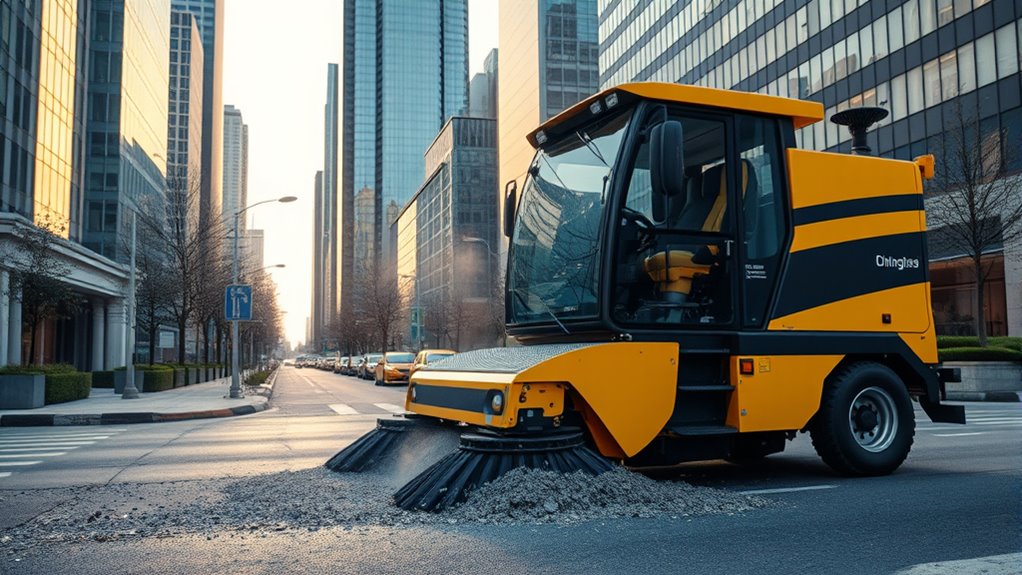Sweeper emissions release dust and pollutants during operation, impacting air quality and urban health. These emissions come from engine exhaust, dust kicked up from cleaning, and particles in generated dust. Modern technology like water spray systems and vacuum methods help reduce airborne particles, while electric or hybrid sweepers emit less pollution. Supporting policies and using cleaner equipment can minimize environmental harm. Keep exploring to discover more about how advancements are making sweeping operations greener and safer.
Key Takeaways
- Sweeper emissions mainly originate from engine exhaust, dust kicked up during cleaning, and particles released at the source.
- Fine particles from sweeper emissions degrade air quality and pose health risks, especially to respiratory-sensitive populations.
- Modern dust suppression techniques like water spray and vacuum systems significantly reduce airborne dust and emissions.
- Advances include electric/hybrid sweepers and improved maintenance, minimizing environmental impact and emissions.
- Policies promoting eco-friendly equipment and community awareness are vital for reducing sweeper-related environmental pollution.

Sweeper emissions substantially impact the environment, especially as urban areas rely more on street cleaning machines to maintain cleanliness. These emissions originate from various parts of the sweeper’s operation, including engine exhaust and dust kicked up during cleaning. The dust generated isn’t just a minor nuisance; it contains fine particles that can harm air quality and pose health risks to residents, especially those with respiratory conditions. That’s why dust suppression techniques are critical in minimizing airborne particles. Modern sweepers are increasingly equipped with water spray systems or vacuum-assisted dust control, which considerably reduce dust emissions by trapping or suppressing dust at the source. Implementing these measures helps improve air quality and demonstrates a commitment to emissions reduction, aligning with environmental standards and public health goals.
Reducing emissions from street sweepers isn’t just about controlling dust; it’s also about lowering the overall environmental footprint of urban maintenance. Newer models are designed to be more fuel-efficient, emitting fewer pollutants during operation. Electric or hybrid sweepers are gaining popularity because they produce no tailpipe emissions, directly contributing to emissions reduction efforts. Switching to these cleaner alternatives helps cities meet stricter air quality regulations and reduces greenhouse gases, which are major contributors to climate change. Additionally, regular maintenance of sweepers ensures crucial engine performance, further minimizing unnecessary emissions. Properly maintained machines burn fuel more efficiently, releasing fewer pollutants and extending their lifespan, which is better for the environment and your city’s budget.
You can also play a role in promoting cleaner street cleaning practices. Advocating for the adoption of advanced sweepers with dust suppression technology helps address environmental concerns directly. When you support policies or initiatives that prioritize emissions reduction, you contribute to cleaner air and healthier communities. Educating others about the importance of dust control not only raises awareness but encourages the use of environmentally friendly equipment. By choosing to operate or endorse sweepers equipped with dust suppression systems, you help reduce the amount of particulate matter released into the atmosphere. Ultimately, addressing sweeper emissions is an essential step toward sustainable urban maintenance, ensuring cleaner streets while protecting air quality for everyone. Additionally, integrating environmental standards into procurement policies can further incentivize the adoption of cleaner technologies.
Frequently Asked Questions
How Do Sweeper Emissions Compare to Other Industrial Vehicles?
You’ll find that sweeper emissions generally have lower comparative emission levels than many other industrial vehicles, thanks to stricter industry standards. Manufacturers design sweepers to meet or exceed industrial vehicle standards, which focus on reducing pollutants. While they still produce emissions, advances in technology help keep their environmental impact minimal compared to heavier machinery or older models, making them a more eco-friendly choice for urban cleaning tasks.
What Are the Latest Regulations on Sweeper Emissions Worldwide?
You should know that, as of 2023, most countries have strict regulatory standards for sweeper emissions, requiring regular emission testing. For instance, the EU mandates that emissions must be reduced by 30% compared to previous levels. These regulations aim to cut pollution and improve air quality. Staying compliant means keeping up with evolving emission testing protocols and adopting cleaner technologies, ensuring your fleet meets the latest environmental standards worldwide.
Are There Eco-Friendly Alternatives to Traditional Sweepers?
Yes, eco-friendly innovations like battery-powered sweepers and those using renewable energy sources offer sustainable cleaning options. These alternatives reduce emissions, energy consumption, and environmental impact. You can choose models with low or zero emissions, making your cleaning practices more sustainable. By opting for these eco-friendly sweepers, you contribute to a cleaner environment while maintaining effective cleaning routines, ensuring a more sustainable future for your community and the planet.
How Do Sweeper Emissions Affect Urban Air Quality?
Your sweeper emissions directly impact urban air quality by releasing dust and particulate matter into the air. These pollutants can worsen respiratory issues and reduce visibility. When sweepers lack effective dust suppression systems, they kick up more particulate matter, making the environment less healthy. To improve air quality, you should consider using sweepers with advanced dust suppression and emission controls, helping to keep urban air cleaner and safer for everyone.
What Advancements Are Being Made to Reduce Sweeper Emissions?
Did you know that electric sweeper models now make up 30% of new purchases? You can see advancements in reducing sweeper emissions through the development of electric models and hybrid technology. These innovations help cut down harmful pollutants and improve air quality. Manufacturers are investing in cleaner, more efficient equipment, so you’ll notice quieter operations and fewer emissions on your city streets, making urban environments healthier for everyone.
Conclusion
You now see how sweeper emissions can really take a toll on the environment. While they might seem like a small piece of the puzzle, every little bit counts when it comes to protecting our planet. It’s clear that addressing these emissions is vital before they spiral out of control. Remember, you can’t put all your eggs in one basket—taking action now guarantees we don’t end up eating our words later.








